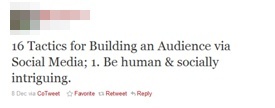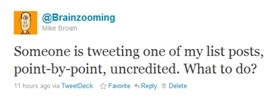As much as people (maybe even you) crave hard and fast rules about what to do and not do in social media, it’s kind of like the Wild West. When the rules aren’t defined, it comes down to whether you want to try and take the law into your own hands. That’s true even for things (such as blatant plagiarism) you’d think would have been clearly spelled out years ago.
One of those situations happened recently.
I wrote an article right before Thanksgiving on “16 Social Media Tactics for Building an Audience” which was republished on several websites, only two of which have my okay to share Brainzooming content.
When one my articles is republished (or there’s a new one written for another blog), I create a Tweetdeck search on the main words in the title. It allows me to track any mentions of the article since many such tweets won’t appear in a standard @mentions search.
 The “social media audience” post search uncovered a guy who had begun tweeting the 16 tips, one-by-one, over a several day period, with no attribution or links back to me or the Brainzooming blog. In other words, plagiarism.
The “social media audience” post search uncovered a guy who had begun tweeting the 16 tips, one-by-one, over a several day period, with no attribution or links back to me or the Brainzooming blog. In other words, plagiarism.
After looking at his Twitter profile (and seeing he worked for a prominent Christian ministry organization), it seemed clear he wasn’t into serial plagiarism.
The cursory investigative work prompted me to post a tweet to ask how others would suggest handling the situation.  The range of responses was surprising, to say the least. From mildest to wildest, they included:
The range of responses was surprising, to say the least. From mildest to wildest, they included:
- “Be flattered and know that your Twitter credibility is higher than that and be satisfied.” @SaraSocialMedia
- “Be grateful. Anyone interested enough to search will find your post. It’s a list post, not literature.” @GrahamHill
- “Send this to them…RT @Lotay Give credit where credit is due.” @MarkVanBaale
- “Call them out, perhaps? If they don’t respond, ask your followers to RT their posts with attribution to you?” @RoyGrubb
- “Call ‘em out! That’s theft. Attribution is so easy, especially on Twitter.” @KatyWrites
- “Let us at him.” @EAlvarezGibson
- “Bust his balls on it with a blog post. I would call him out, and then tweet it at him.” @NateRiggs
- “Out them, block their ISP, tell them to stop publically, pull down the post, tweet your points w/ your post link, etc.” and “Want us to kick ‘em in the shins?” @TheGirlPie
- “Hire the Twittenator.” @A_Greenwood
Talk about a range of responses – from “take the high road” to down-in-the-dirt, post-modernist gun slinging.
What did I do?
I followed the guy on Twitter, he followed back, and I sent him a DM. I told him about seeing him tweeting the post and suggested some type of credit or link was in order. He responded by saying he’d do that and thanking me for both the reminder and the original post.
What’s happened since?
Nothing. He stopped after the first five of the 16 ideas, and in tracking his Twitter stream, it doesn’t look like he’s ever gone back and tried to provide any credit.
In the end, this wasn’t a big deal.
In fact, the bigger lessons for me (and hopefully for you) are the benefits of setting up multiple searches to track mentions about your content, and the fact you can depend on loyal friends to readily form a cyber-posse and help you deal with lawlessness on the web! – Mike Brown
The Brainzooming Group helps make smart organizations more successful by rapidly expanding their strategic options and creating innovative plans they can efficiently implement. Email us at brainzooming@gmail.com or call 816-509-5320 to learn how we’ve developed integrated social media strategy for other brands and can do the same for yours.


